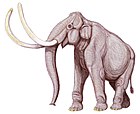用戶:Lureplant/沙盒
| Lureplant/沙盒 化石時期:
| |
|---|---|

| |
| 淮河古菱齒象全身骨骼,展示於臺灣國立自然科學博物館 | |
| 科學分類 | |
| 界: | 動物界 Animalia |
| 門: | 脊索動物門 Chordata |
| 綱: | 哺乳綱 Mammalia |
| 目: | 長鼻目 Proboscidea |
| 科: | 象科 Elephantidae |
| 屬: | †古菱齒象屬 Palaeoloxodon |
| 種: | Lureplant/沙盒 P. huaihoensis
|
| 二名法 | |
| Palaeoloxodon huaihoensis Liu, 1977
| |
| 異名 | |
| |
淮河古菱齒象(學名:Palaeoloxodon huaihoensis)是長鼻目象科古菱齒象屬下的一個物種,生存於更新世時期的中國華北地區以及臺灣澎湖水道。
分類學[編輯]
淮河古菱齒象原被認為是諾氏古菱齒象的亞種,現已被歸類成獨立種 It was first named a subspecies of P. naumanni (which is principly known from material found in Japan) by J. Liu in 1977 based on a partial skeleton from Huaiyuan, Anhui,[1] and was later elevated to species rank by G. Qi in 1999, who also included other Chinese Palaeoloxodon remains within species, including the abundant remains found in the Penghu Channel between the Penghu archipelago and Taiwan.[2][3] A mostly complete adult skull (IVPP V4443) from Late Pleistocene Nihewan basin in Hebei may be referrable to this species.[3]
描述[編輯]
The body size is very large, comparable to Indian Palaeoloxodon namadicus and the European straight-tusked elephant (P. antiquus). In comparison to Indian P. namadicus, the postcranial skeleton is substantially more robust, and greatly resembles that of P. antiquus. The morphology of IVPP V4443 is also overall more similar to that of P. antiquus than P. namadicus, but the parietal-occipital crest at the top of the skull displays a very robust morphology closer to that of P. namadicus.[3]
分佈與棲息地[編輯]
Remains of Palaeoloxodon are widespread in China, ranging from Northeast China to Xinjiang in the northwest to Hainan and Yunnan in the south, though most remains of Palaeoloxodon in China are from the North China Plain region.[4] Material from the Pengu Channel sample predominantly represents adult individuals.[5]
演化與滅絕[編輯]
The oldest remains of Palaeoloxodon in North China date to the early Middle Pleistocene, around 700,000 years ago.[6] The latest dates for Palaeoloxodon in China are from the Late Pleistocene, and a Holocene survival is not substantiated,[7] though the actual timing of extinction is uncertain due to a lack of reliable dating.[4] Mitochondrial genomes retrieved from Chinese Palaeoloxodon individuals from North China reveal that like the European P. antiquus, they harboured mitochondrial lineages derived from those of African forest elephants as a result of hybridisation with that species prior to Palaeoloxodon leaving Africa.[4] The close relationship between the mitochondrial genomes of a Chinese Palaeoloxodon and a European P. antiquus individual suggests that there may have been gene flow between the two populations following their initial divergence.[4]
Diagram of the relationships of elephant mitochondrial genomes, after Lin et al. 2023.[4]
| |||||||||||||||||||||||||||||||||||||||||||||||||||||||||||||||||||
參考文獻[編輯]
- ^ J. Liu Palaeoloxodon from Huaiyuan District, northern part of Anhui Vertebr. Palasiat., 15 (1977), pp. 272-284
- ^ G. Qi On some problems of Palaeoloxodon of China (in Chinese with English Abstract) Y. Wang, T. Deng (Eds.), Proceedings of the Seventh Annual Meeting of the Chinese Society of Vertebrate Paleontology, China Ocean Press, Beijing (1999), pp. 201-210
- ^ 3.0 3.1 3.2 Larramendi, Asier; Zhang, Hanwen; Palombo, Maria Rita; Ferretti, Marco P. The evolution of Palaeoloxodon skull structure: Disentangling phylogenetic, sexually dimorphic, ontogenetic, and allometric morphological signals. Quaternary Science Reviews. February 2020, 229: 106090. Bibcode:2020QSRv..22906090L. S2CID 213676377. doi:10.1016/j.quascirev.2019.106090 (英語).
- ^ 4.0 4.1 4.2 4.3 4.4 Lin, Haifeng; Hu, Jiaming; Baleka, Sina; Yuan, Junxia; Chen, Xi; Xiao, Bo; Song, Shiwen; Du, Zhicheng; Lai, Xulong; Hofreiter, Michael; Sheng, Guilian. A genetic glimpse of the Chinese straight-tusked elephants. Biology Letters. July 2023, 19 (7). ISSN 1744-957X. PMC 10353889
 . PMID 37463654. doi:10.1098/rsbl.2023.0078 (英語).
. PMID 37463654. doi:10.1098/rsbl.2023.0078 (英語).
- ^ Kang, Jia-Cih; Lin, Chien-Hsiang; Chang, Chun-Hsiang. Age and growth of Palaeoloxodon huaihoensis from Penghu Channel, Taiwan: significance of their age distribution based on fossils. PeerJ. 2021-04-14, 9: e11236. ISSN 2167-8359. PMC 8052959
 . PMID 33954049. doi:10.7717/peerj.11236
. PMID 33954049. doi:10.7717/peerj.11236  (英語).
(英語).
- ^ Jin, Changzhu; Wang, Yuan; Liu, Jinyuan; Ge, Junyi; Zhao, Bo; Liu, Jinyi; Zhang, Hanwen; Shao, Qingfeng; Gao, Chunling; Zhao, Keliang; Sun, Boyang; Qin, Chao; Song, Yayun; Jiangzuo, Qigao. Late Cenozoic mammalian faunal evolution at the Jinyuan Cave site of Luotuo Hill, Dalian, Northeast China. Quaternary International. 2021-03-10, 577: 15–28. ISSN 1040-6182. doi:10.1016/j.quaint.2021.01.011 (英語).
- ^ Turvey, Samuel T.; Tong, Haowen; Stuart, Anthony J.; Lister, Adrian M. Holocene survival of Late Pleistocene megafauna in China: a critical review of the evidence. Quaternary Science Reviews. September 2013, 76: 156–166. doi:10.1016/j.quascirev.2013.06.030 (英語).
外部連結[編輯]
- 假日專題解說 ─ 古菱齒象 (頁面存檔備份,存於互聯網檔案館) - 國立自然科學博物館
| ||||||||||||||||||||||||||||||||||||||||||||||||||||||||||||||||||||||||||||||||||||||||||||||||||||||||||||||||||||||




